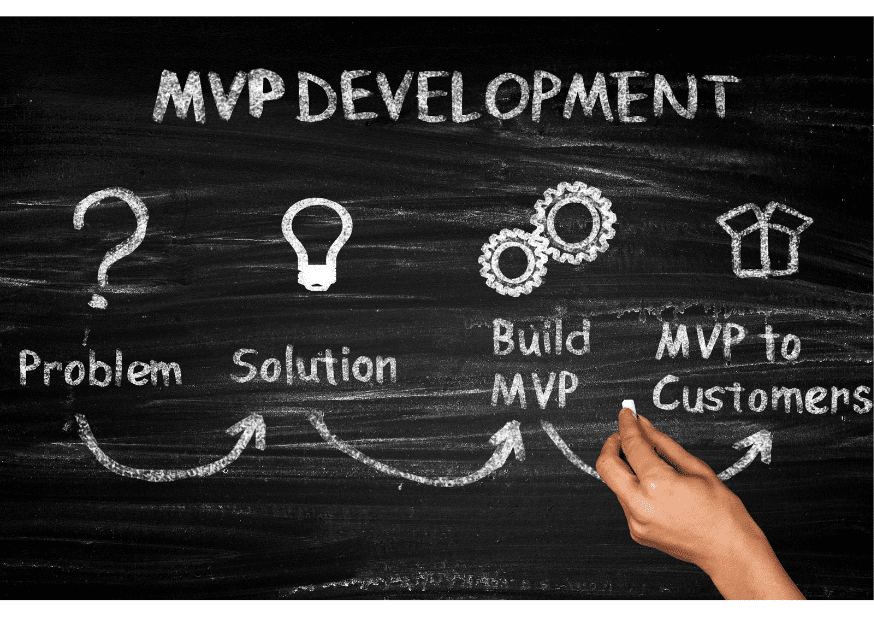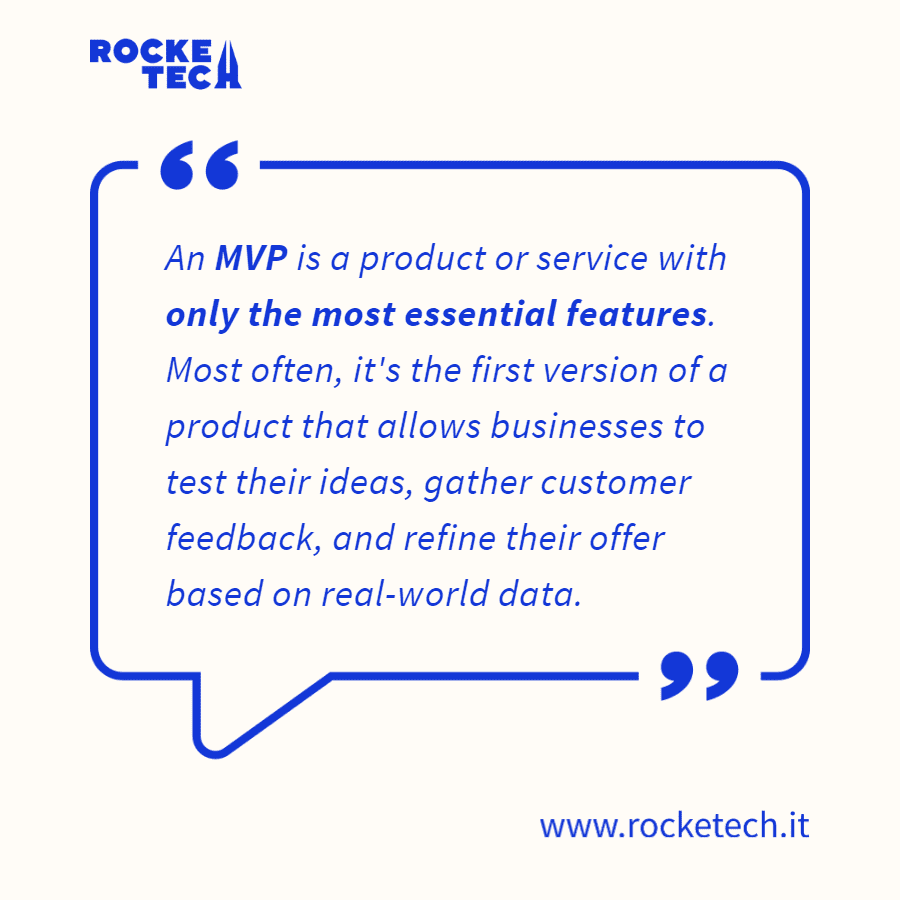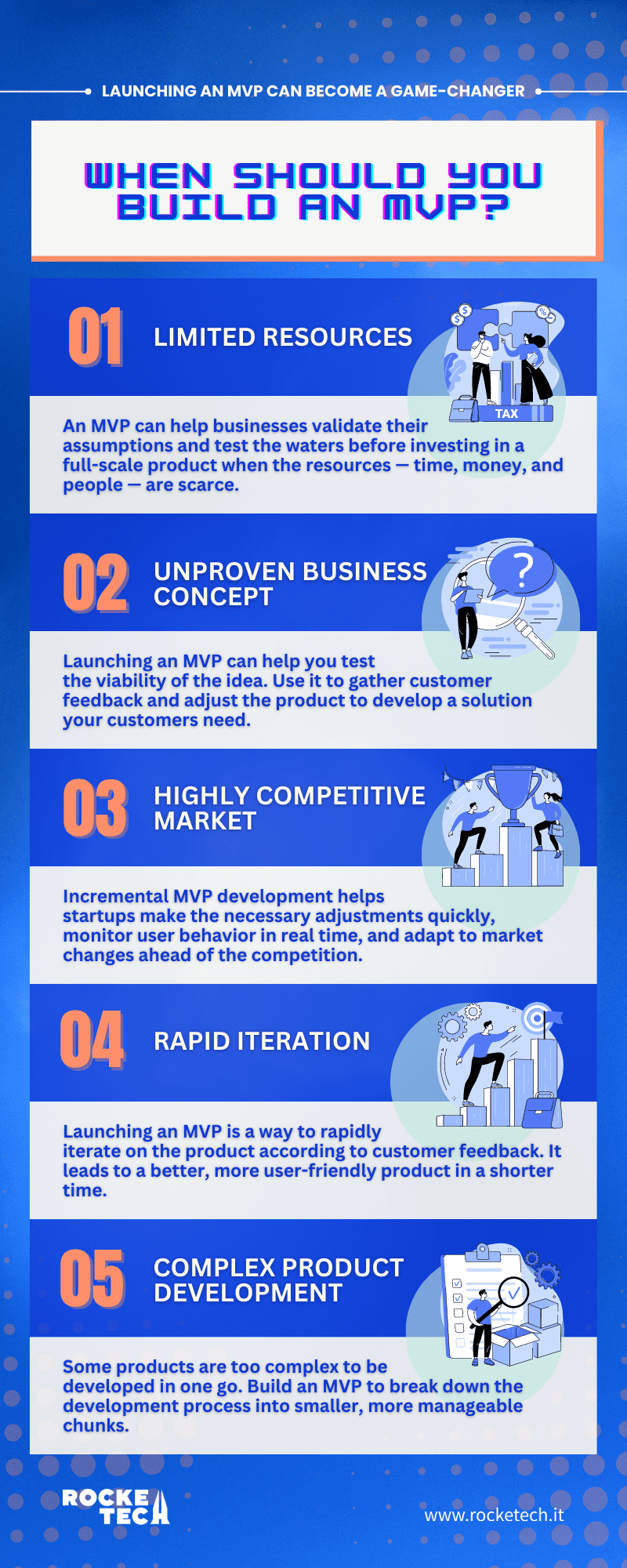When launching a new product or service, businesses often aim for perfection. They want to deliver a flawless offer that will exceed customer expectations and dominate the market. But in reality, this approach is both time-consuming and risky.
What if your idea isn’t as great as you thought it was? What if your target audience doesn’t actually need what you’re selling? This is where the concept of the minimum viable product (MVP) comes in.

The Art of Launching: Why MVPs are Essential for Startups
We already covered the core differences between the three main pre-development strategies — prototyping, proving a concept, and building an MVP. However, minimum viable product examples are worth a more detailed discussion.

An MVP is an essential step in startup development when it’s critical to mitigate risks. Its main goal here is to help startups test business hypotheses and get the product to market as quickly as possible. An MVP makes creating great products possible without large investments yet with maximum benefits.
Testing the Waters: The Advantages of Launching an MVP
Building an MVP for startups is a careful and rational approach. In most cases, it helps businesses avoid many mistakes and creates significant leverage over those who create a full product at once.
- You can test your idea‘s viability without spending a lot of time, effort, and money. If there’s no market need for your product, you’ll see it quickly and won’t have to regret the overinvestment. You can move in a different direction.
- You can better identify and understand your audience. An MVP will demonstrate whether your potential customers need your solution and how exactly they will use it.
- You can see what works well and what needs changes and adjustments. It’s not uncommon to completely redo the whole application or its parts due to negative feedback. And it’s a huge advantage — by doing so, you have a better chance to develop the product in high demand.
- If the MVP launch is successful, you’ll get your first profit and customers well before the final version. This will help you pay off your investment faster and find people who are more likely to become your regular users.
- A functioning and strong MVP can help you attract investments by providing a tangible product or service that investors can evaluate and understand. By demonstrating a clear market need and showcasing a solution that meets that need, startups can prove their viability and potential for growth. Additionally, an MVP can help startups refine their business model and strategy, giving investors more confidence in their ability to succeed.
On top of that, people may not need some of the features you planned to spend a lot of time and effort on. Launching an MVP will reduce the cost and time of development and allow you to focus on what the audience requires most.
Get Ahead of the Game: 7 Scenarios When to Build and Launch Your MVP
MVP development is based on constructing hypotheses you need to confirm or disprove. You don’t just run the app’s demo version but analyze what you need to add, remove, or improve depending on user behavior and feedback.
The good thing about MVPs is that they can be anything, any new product — whether it’s a branching off from an existing one, a new major feature in a full-fledged product, or the development of a new application. With a certain share of creativity, you can even test new restaurant menus or product lines of a physical store.
Here are seven hypothetical yet likely scenarios when you need to launch an MVP to stay ahead of the competition, survive difficult market conditions, and succeed overall.
#1 Innovative Idea with a Limited Budget
The most common case. You have an innovative idea for a product, but you’re unsure if there’s enough demand to justify a full-scale launch. By creating an MVP, you can test the market with a simplified version of your product and gather feedback from early users. This can help you validate your idea, make improvements based on customer feedback, and conserve resources before investing in a full-scale launch.
#2 Expanding Into a New Market
Another frequent scenario is an established company looking to expand into a new market. Imagine you’ve done your research and identified a gap in the market that your product could fill, but you’re not sure if your existing offer will resonate with the unexplored audience. By creating an MVP tailored to the new market, you can gauge the interest and avoid costly mistakes.
#3 Too Many Features Planned
Imagine your business is developing a new software application. You already have a long list of features you want to include, but you’re not sure which ones are the most important to your customers.
✔ By releasing an MVP with only the most essential features, you can gather feedback from early users and simply ask them what they are missing in your solution. This way, you create a more customer-centric product and avoid wasting resources on features that don’t add value.
#4 Existing Offer Becomes Outdated
Quite often, well-established companies with a long history of success also realize their existing offerings are becoming outdated and they’re losing ground to newer, more innovative competitors.
✔ If this is your case, by testing a new product or service, you can demonstrate your commitment to innovation and position your company as a forward-thinking leader in your industry.
#5 A Retail Store Going Online
Another good scenario to build an MVP app is a retail store developing a new e-commerce platform. With the rise of online shopping, you need to offer a seamless shopping experience to compete with established retailers. However, in many cases, the store owner has limited experience with e-commerce and is unsure which features will resonate with the target audience.
✔ Start with the absolute minimum — a user-friendly interface and secure payment processing — and refine your solution by adding more complex features according to your first buyers’ feedback.
#6 A B2B Company Launching a New Service
Imagine a B2B service company that has been offering the same set of services for several years. While the company has a loyal customer base, the management is aware they need to diversify the company’s offers and stay ahead of the competition.
✔ By launching an MVP, the company can test the market demand for the new service and validate its potential value to customers before spending dramatic budgets on full-scale development and launching a large advertising and marketing campaign.
#7 A Growing Restaurant
The MVP’s versatility allows using it not only in tech startups but in many other industries. For example, a restaurant looking to expand its menu may also benefit from this approach.
Imagine you’re the restaurant’s owner, have limited kitchen space, and are unsure which new menu items will be popular with the customers. A simple restaurant app will help you test your new menu items and special offers and analyze your customers’ taste preferences.

MVP Development with Rocketech
An MVP allows you to quickly and cost-effectively test new ideas and get early feedback from customers, helping you to identify and address any potential issues before committing significant resources to a full-scale launch.
Our experience shows that by leveraging the insights gained from the MVP, you can refine and improve your product or service, and ultimately gain a competitive advantage in the market. With a successful MVP, you can attract new customers, retain existing ones, and solidify your position as a leader in your industry.
MVP Development FAQ
What is an MVP?
An MVP is a cost-effective way to test a business idea by creating a basic product version with just enough features to validate its marketability.
How much does it cost to build an MVP?
The cost of building an MVP varies based on the complexity of the product, but it generally ranges from $50,000 to $150,000.
Is an MVP a prototype?
An MVP is a type of prototype, but not all prototypes are MVPs. An MVP is specifically designed to test the market viability of a product.
How do you develop an MVP?
To develop an MVP, start with a hypothesis, identify the core features required to test the assumption, and build the product as quickly and cost-effectively as possible.
What does an MVP mean in business?
In business, an MVP means creating a basic product version with just enough features to test its market viability and validate the idea before investing significant resources in a full-scale launch.
What is MVP in software development?
In software development, an MVP is an iterative development approach that involves building the basic version of the product with minimal features to test the market demand and gather user feedback.
What comes after an MVP?
After an MVP, the product can be improved and scaled up based on user feedback and market demand, with the ultimate goal of creating a successful product that meets the target audience’s needs.
How long should it take to build an MVP?
The time required to build an MVP varies based on the complexity of the product, but on average, it takes 4-6 months to develop an MVP.